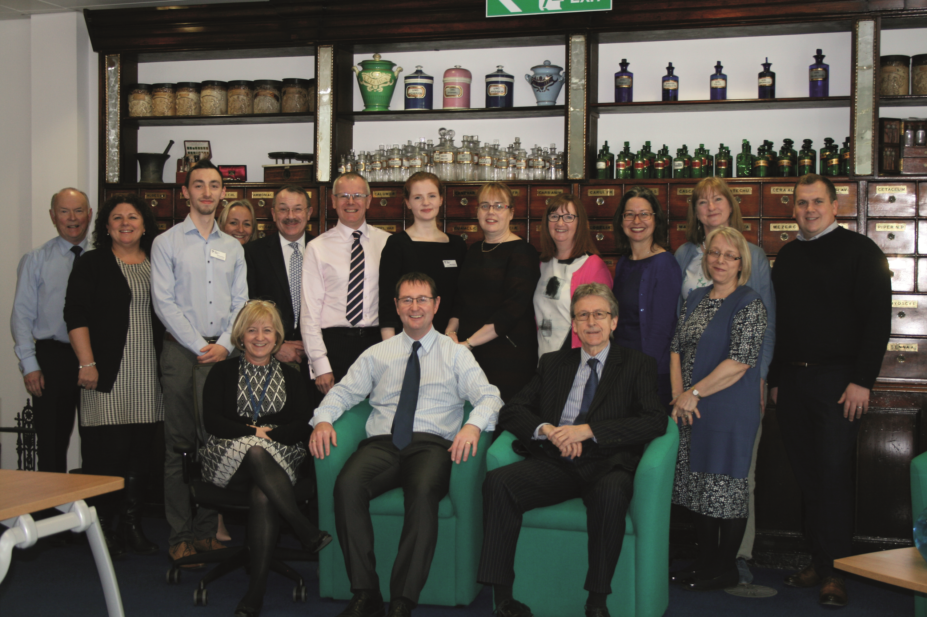
Royal Pharmaceutical Society, Scotland
The Royal Pharmaceutical Society’s (RPS) Scottish Pharmacy Board (SPB) held its second open meeting of the year at Holyrood Park House, Edinburgh, on 26 April 2017.
Guests at the meeting included: Jacqueline Sneddon, project lead for the Scottish Antimicrobial Prescribing Group (SAPG), Mara Gilchrist and Tom Byrne from the British Pharmaceutical Students’ Association (BPSA); Heather Harrison, educational development pharmacist at the RPS; Fiona McMillan, principal lead in vocational training and leadership development at NES Pharmacy; Annamarie MacGregor, practice development lead; and Susanne Cameron-Nielsen, head of external relations at RPS Scotland.
Business and public affairs
Updating attendees on progress with the SPB’s business plan, Aileen Bryson, interim director for Scotland, announced that all plans were on track for the year. She said that partnerships with the 17 other health professional bodies in Scotland were proceeding as planned, and a meeting with the Royal College of Nursing was taking place the following Friday.
Bryson also noted that the RPS’s activity around long-term conditions had received good coverage in the Glasgow Herald, and that the recent science-based exhibition held by the society at the Scottish parliament had been “fantastically successful”. Plans for the rest of the year include, among others, establishment of an RPS Scotland Innovators forum to support the development of RPS professional and clinical workstreams; the promotion of pharmacy as a science-based profession, and encouragement of more pharmacies into the RPS’s Research Ready programme, and reintroduction of the RPS Care Homes work into the planned Scottish Government working group on improving the care of people in care homes.
Susanne Cameron-Nielson, head of external relations at RPS Scotland, then reported on RPS Scotland’s public affairs activity. A highlight of quarter one, she said, was the RPS exhibition held in the Scottish Parliament between 7—9 March 2017. Sponsored by Maree Todd MSP, the exhibition aimed to promote RPS Scotland’s manifesto, and also the greater use of pharmacists’ clinical skills. During the three days, Society delegates — including Aileen Bryson — met with 36 MSPs and obtained 18 new pledges for the manifesto.
Catherine Duggan, director of professional development and support, told the board that the National Institute for Health and Care Excellence has accredited the process used by the Society to develop its professional standards and guidance, which is a significant development for the Society. The accreditation now covers the ‘RPS competency framework for all prescribers’, and will be applied (including retrospectively) to all guidance documents developed using the accredited procedure.
Antimicrobial stewardship in Scotland
In the final update of the morning session, guest speaker Jacqueline Sneddon, project lead for the Scottish Antimicrobial Prescribing Group (SAPG), led a workshop during which she summarised the SAPG’s activities during the past 12 months and asked the board to consider what could be done to support the group’s work.
During her presentation, Sneddon explained how the SAPG was formed in March 2008 at the request of the Scottish Government Health Department, and aims to set a national framework for antimicrobial stewardship. Sneddon noted that in Scottish hospitals, use of antimicrobials — particularly broad spectrum — is increasing, with around a third of hospital patients receiving antibiotics and up to half of those prescriptions potentially being inappropriate.
SAPG provides training materials and resources for health professionals in Scotland, and has developed the Scottish Reduction in Antimicrobial Prescribing (ScRAP) Programme to help reduce the number of unnecessary antimicrobial prescriptions. An app, Antimicrobial Companion, has also been created to assist prescribers in hospital settings.
In primary care, total antimicrobial use is decreasing as a consequence of the group’s activity, Sneddon said, although usage rates remain higher than in comparable English settings. Hospital pharmacists can liaise with wider healthcare teams to help stem this trend, Sneddon said, with use of benchmarking data, and feeding back of prescribing data to GPs, being examples of how this can work.
Sneddon noted that a patient-oriented leaflet, ‘Self help guide to treating your infection’, had been piloted in Scotland in 2014 and 2015, but despite being a “great leaflet” had not been taken up very widely. A poster and patient leaflet, both featuring a “scary bacteria” and encouraging patients to treat common colds, coughs or sore throats with non-antimicrobial interventions, had also been used to good effect (42% of pharmacists surveyed said the poster engaged customers, and 84% thought the leaflet was useful) but the ongoing production of these resources is at risk from reduced funding.
Although hospital and primary care pharmacists are well supported by the SAPG, engagement with community pharmacy remains a challenge, Sneddon reported. In fact, the SAPG currently has no community pharmacist member. The group is now focusing on promoting community pharmacy as the first port of call for minor infections, and the evolving role of community pharmacists in the control of antimicrobial supply (which may include point of care testing to check whether antimicrobials are needed: an initiative which has not yet been trialled in Scotland).
After Sneddon’s brief, the board broke out into two groups to discuss activities that could support the work of the SAPG. Suggestions from the board included: working with the pharmaceutical industry to highlight the development of new drugs; increasing direct communication between GPs and pharmacists (for example, by visiting each other’s workplaces), and also building relationships between community pharmacists and pharmacists in GP surgeries; promoting the Research Ready programme; communication on the subject through The Pharmaceutical Journal, and continuing to campaign for full access to patient records (in particular, to help pharmacists understand why a GP may have prescribed an antibiotic).
Future of pharmacy — the BPSA
view
After a break, the second guest presentation of the meeting was delivered by Mara Gilchrist and Tom Byrne of the British Pharmaceutical Students’ Association (BPSA). They presented the findings of the BPSA report on the ‘Aspirations and expectations of pharmacy students’. The BPSA surveyed 1,374 pharmacy students across the UK (74.7% of which were in their first year of study, 7.0% in their second year, 7.5% in their third year and 10.8% in their final year).
The survey found that 92.5% of students are interested in prescribing during their future careers. Multi-sector working was also attractive, with 76.7% of respondents saying that they would like to complete their pre-registration year in more than one area of practice. The accessibility of pharmacists as primary care providers was also considered important, with 84% of students agreeing that “clinical pharmacy services should be available seven days a week” — although a smaller proportion — 78.5% — of respondents said that they would be willing to work on rotas to support this open-all-hours approach.
The BPSA report states that the profession’s attitude “can at times be deferent and inward- looking”, and that they would like to see more of a bold, ambitious and confident mind-set among pharmacists”. In response to a question from Aileen Bryson, interim director for Scotland, as to whether his university education had left him feeling confident and assertive, Byrne said he personally felt well-prepared for professional life but acknowledged that student experience may vary by school and even by sector entered. Gilchrist added that some pre-registration trainees could use more support to develop professional confidence, with some feeling that they are in a ‘limbo state’ in which they are no longer students, but are not yet qualified pharmacists.
The board thanked Gilchrist and Byrne for their presentation on behalf of the BPSA, with John McAnaw, chair of the SPB, promising that the board would listen and reflect on the BPSA report.
Multi-sector training
A new approach to vocational training was presented by Fiona McMillan, principal lead in vocational training and leadership development at NES Pharmacy, and Heather Harrison, educational development pharmacist at the RPS.
The RPS and the NES, McMillan and Harrison reported, have jointly developed a pilot vocational training foundation programme for community pharmacists, which will open for applications on 1 June 2017.
Existing NES vocational training for pharmacists has focussed on hospital and primary care settings – the new programme incorporates community pharmacy for the first time. It will be a two-year foundation training programme which will allow participants to train cross-sector: i.e. in hospital, primary care and community pharmacy. The programme will be RPS-accredited, so those completing it will be considered to have completed the RPS foundation stage.
Following the call for applications, ten Scottish community pharmacists will be selected to begin their training on 1 September 2017. There was general approval from the board, with John Cromarty noting that fully integrated training reflects what is actually happening in practice and Tom Byrne adding that this kind of training would be welcomed by the BPSA. Ewan Black questioned whether the opportunity would be made available to more mature pharmacists, as well as those in the early stage of their careers, to which McMillan responded that although the scheme was aimed at early-career pharmacists, “no-one would be barred”.
Changes to local engagement
Finally, Annamarie updated the board on developments in local engagement and the RPS quality roadshows.
RPS Scotland is changing its model of local engagement, moving from local practice forums (LPFs) to new ‘RPS Local’, covering NHS Board areas. RPS Scotland has, she reported, been engaging with members about what they need from local engagement — including holding a local member engagement day in February 2017. It was noted that greater use of webinars and digital platforms would help people working rurally; for example in Orkney, the Shetlands and the Highlands. Advertisements for new local co-ordinators have now been published in The Pharmaceutical Journal.
McGregor also reported that the quality roadshows programme had been successful, with some useful feedback including that more information on error reduction would be welcomed, as would more work on error reporting standards. In particular, independent pharmacies, it was felt, may need more support to develop robust error reporting procedures.
The meeting ended with thanks to departing board member Andrea Smith, with McAnaw highlighting Smith’s “positive and focused contribution” during the terms she has served.
- The next meeting of the Scottish Pharmacy Board is scheduled for Wednesday 14 June.
You may also be interested in
Long service of members

Membership fees 2022
